Domain Health Check for Pardot (Account Engagement) Email Deliverability
- February 16, 2023
- Email Delivery, Salesforce Ben | The Drip
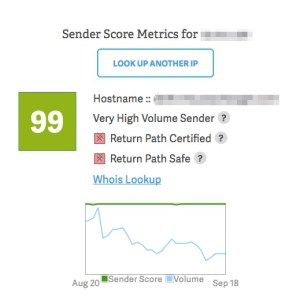
The health of your email sending domain is something you should keep an eye on – it’s essential for Pardot email deliverability. Your sending reputation is how Email Clients/ISPs (Internet Service Providers) decide whether to let your email into the recipient’s inbox, or not. Just like how reputation works in other scenarios, sending reputation is something you build over time, and constantly strive to be better.
If you get listed on a ‘blacklist’/’blocklist’, then there’s a diminishing chance of your emails reaching their intended destination – in the inboxes of your prospects. This guide covers the admin tasks I do to ensure we are keeping a pulse with our sending reputation, and therefore, not damaging our Pardot email deliverability. The three-part process involves inspecting the damage, resolving the damage, and putting measures in place to prevent future mishaps.
Why You’re in the Spam Folder
Why your emails may find themselves in the spam folder all boils down to your sender reputation – something Internet Service Providers (ISPs) always keep an eye on. To them, it’s an indicator of your behavior as a sender. Sure, you’ve added all of the email authentication protocols (SPF, DKIM, etc.) but that’s not enough to guarantee deliverability – it’s not a ‘set and forget’ exercise.
What determines your sending reputation? In a nutshell, everything you do when it comes to email marketing:
- The number of emails you send and the bounces you get.
- Your average spam complaint rate.
- The number of spam traps your emails hit (more on spam traps here).
- Your overall email engagement: click-through rates, replies and forwards.
The reason email list verification is so important to marketers today is that it helps improve all of these metrics – and it does so fast.
1. Check Your Sending IP Health
Inspect the damage. To check your sending IP reputation (aka ‘health’), you have to find your IP and run a check on a 3rd party site.
To find your sending IP in Pardot, navigate to: Pardot Settings → Account Settings → you will see ‘Sending IPs’ in the left column. Copy this number for later – it should be in a format similar to “00.000.0.00”.
Note: You are looking for your email sending IP, not your computer’s IP address. Find this in the account settings in Pardot.
Shared IP vs. Dedicated IP
- With a shared IP, you are using Pardot’s (Exacttarget) server address. The benefits of a shared IP is that Pardot are monitoring deliverability to protect all of their customers. Plus, you don’t have to go through the lengthy process of IP warm-up to prevent email clients (inbox providers) blocking your mail.
- With a dedicated IP, your deliverability is dependent on your sender reputation (and yours alone).
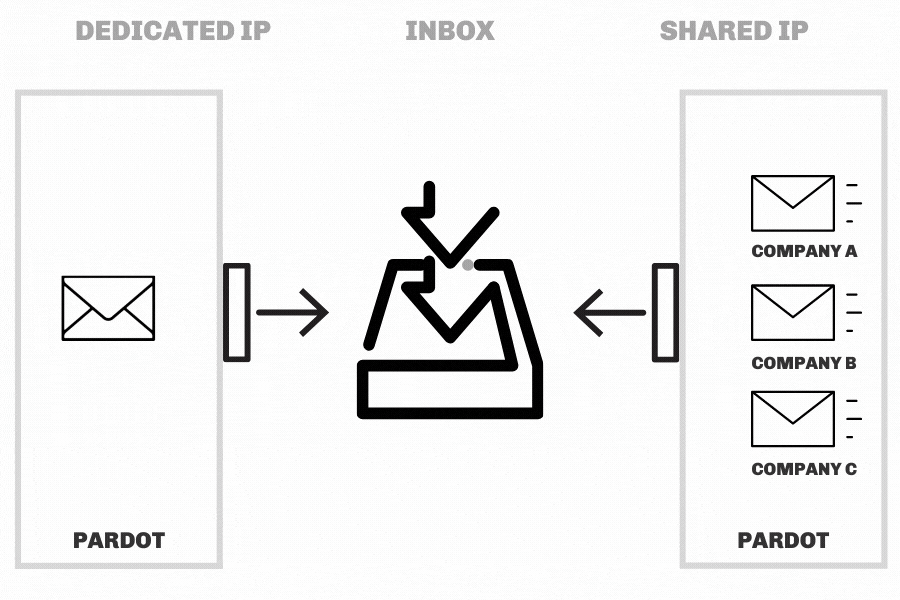
2. Check Your Sending Reputation
I can recommend three third-party websites that I’ve used to perform this health check:
Senderscore.org
Senderscore.org is a free tool that gives you what you need in a user-friendly format. Access detailed reputation reports – including how email clients (aka ISPs) look at incoming mail to mitigate spam reaching recipients.

Here’s an overview example, shown over the last 30 days:

And the Reputation Measures Report, which uses a traffic light system:
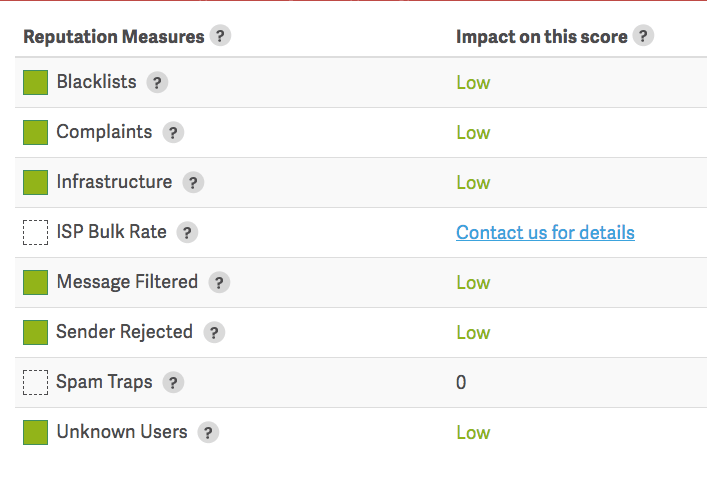
MX Toolbox

MX Toolbox is the tool that Pardot support will refer to when you reach out to them. Although it gives them the insight they need, the details are not easy to interpret (well, at least for me anyway!).
If you do find yourself on a blacklist like SORBS in the short term, you can reverse it with little harm done. It’s repeat offences that will send alarm bells ringing – major offences will rapidly result in being banned from using Pardot.
250ok
A paid-for email analytics platform that not only allows you to closely monitor sender reputation and blacklists, but also seedlist testing, security, email authentication, inbox rendering, and more.
3. Sent Emails Report
Resolve the damage. Who are the culprits? You’re about to find out!
Getting to the send emails report page will allow you to sort and filter the stats you need to take action.
Navigate to: Pardot Reports → Emails → List Emails.
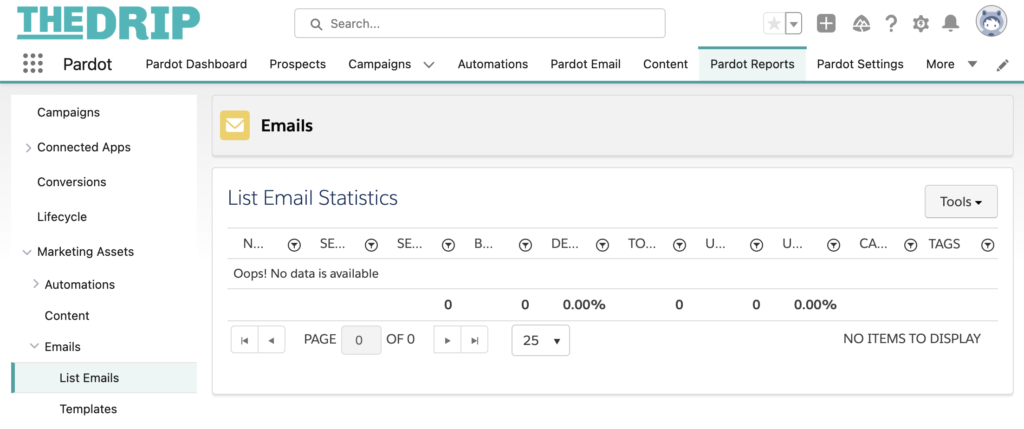
You will want to look at these Pardot email deliverability metrics, so add these column by clicking on any column filter (funnel icon on table header), and hover over “Columns”.
Make the selection like the screenshot to the right:
- Sent
- Bounces
- Delivery Rate
- Spam Complaints
- Hard Bounces
- Soft Bounces
- Opt Outs
- Spam Complaint Rate
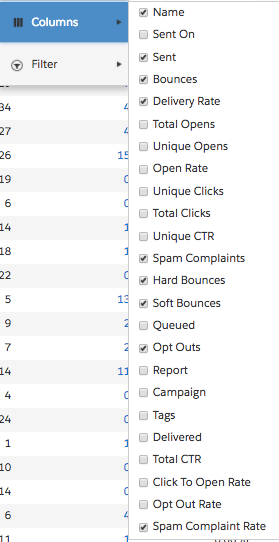
Let’s take Hard Bounces first.
A Hard Bounce means that no email can reach this person’s inbox. It could be because the recipient is deactivated, or there were 5 soft bounces (which automatically equals a hard bounce).
It’s marked on the prospect record like this:

You need to clear these prospects from your account.
Click on the hyperlinked email title. In the email report, click on the hyperlinked number of hard bounces (shown below).

You will land on the Hard Bounces table. You will see the ‘Bounce Reason’ column, some are more serious than others, e.g. 5.0.0. If you have a bad email sending reputation, consult an expert.
Create an automation rule with the criteria: Prospect email status — is — Hard bounce detected.
You can flag these prospects to other teams in your organization (i.e. the sales team) or ‘soft delete’ prospects to the recycle bin.
Summary: Put Your Best Foot Forward
The health of your email sending domain is something you should keep an eye on. When damaged, there’s a diminishing chance of your emails reaching their intended destination – in prospect email inboxes.
Once you have gone through inspecting the damage and resolve the damage, it’s now time to put measures in place to prevent future damage.
- Schedule time to do this three-part process monthly, or whenever you suspect deliverability foul play.
- Use an email verification service to identify bad email addresses before you attempt to send emails to them.
- Consider changing users to the ‘sales manager’ or ‘sales’ user roles, as these do not include list email sends.
- Use recency and frequency lists to control email sending volume. These can be rules-based (dynamic lists) or use Einstein Engagement Frequency (AI-driven).
This Pardot article written by:
Salesforce Ben | The Drip
Lucy Mazalon is the Head Editor & Operations Director at Salesforceben.com, Founder of THE DRIP and Salesforce Marketing Champion 2020.
Original Pardot Article: https://www.salesforceben.com/the-drip/domain-health-for-pardot-email-deliverability/
Find more great Pardot articles at www.salesforceben.com/the-drip/
Pardot Experts Blog
We have categorized all the different Pardot articles by topics.
Pardot Topic Categories
- Account Based Marketing (ABM) (7)
- Business Units (14)
- ChatGPT / AI (3)
- Completion Actions (5)
- Connectors (10)
- Custom Redirects (4)
- Data Cloud (3)
- Demand Generation (8)
- Dynamic Content (7)
- Einstein Features (11)
- Email Delivery (17)
- Email Open Rates (3)
- Pardot A/B Testing (2)
- Email Mailability (16)
- Do Not Email (1)
- Double Opt-in (2)
- Opt Out / Unsubscribe (14)
- Email Preferences Page (6)
- Engagement Studio (16)
- Industries (1)
- Non Profit (1)
- Landing Pages (9)
- Lead Generation (1)
- Lead Management (13)
- Lead Routing (3)
- Lead Scoring (16)
- Leads (3)
- Marketing Analytics – B2BMA (9)
- Marketing Automation (1)
- Marketing Cloud (3)
- Marketing Cloud Account Engagement (4)
- Marketing Cloud Growth (2)
- New Pardot Features (6)
- Opportunities (2)
- Optimization (2)
- Pardot Admin (65)
- Duplicates (1)
- Marketing Ops (1)
- Pardot Alerts (1)
- Pardot API (2)
- Pardot Automations (3)
- Pardot Careers (12)
- Pardot Certifications (4)
- Pardot Consulting (1)
- Pardot Cookies (4)
- Pardot Custom Objects (3)
- Pardot Email Builder (8)
- Pardot Email Templates (10)
- HML (6)
- Pardot Events (17)
- Pardot External Actions (1)
- Pardot External Activities (4)
- Pardot Forms (29)
- Form Handlers (8)
- Pardot Integrations (21)
- Data Cloud (2)
- Slack (1)
- Pardot Lead Grading (5)
- Pardot Lead Source (2)
- Pardot Lightning (1)
- Pardot Migration (1)
- Pardot Nurture / Drip Campaigns (2)
- Pardot Personalization (3)
- Pardot Profiles (1)
- Pardot Releases (18)
- Pardot Sandboxes (2)
- Pardot Segmentation (5)
- Pardot Strategy (7)
- Pardot Sync (2)
- Pardot Sync Errors (1)
- Pardot Tracker Domains (5)
- Pardot Training (3)
- Pardot Vs Other MAPs (4)
- Pardot Website Tracking (2)
- Reporting (22)
- Salesforce and Pardot (31)
- Marketing Data Sharing (2)
- Pardot Users (3)
- Salesforce Automation (5)
- Salesforce Flows (2)
- Salesforce Campaigns (22)
- Salesforce CRM (3)
- Record Types (1)
- Salesforce Engage (3)
- Salesforce Queues (2)
- Security and Privacy (1)
- Tags (3)
- The Authors (540)
- Cheshire Impact (9)
- Greenkey Digital (55)
- Invado Solutions (37)
- Jenna Molby (9)
- Marcloud Consulting (6)
- Nebula Consulting (67)
- Pardot Geeks (44)
- Salesforce Ben | The Drip (242)
- SalesLabX (16)
- Slalom (4)
- Unfettered Marketing (51)
- Uncategorized (1)
- Website Tracking (2)
- Website Search (1)
More Pardot Articles
See all posts
This Pardot article written by:
Salesforce Ben | The Drip
Lucy Mazalon is the Head Editor & Operations Director at Salesforceben.com, Founder of THE DRIP and Salesforce Marketing Champion 2020.
Original Pardot Article: https://www.salesforceben.com/the-drip/domain-health-for-pardot-email-deliverability/
Find more great Pardot articles at www.salesforceben.com/the-drip/






